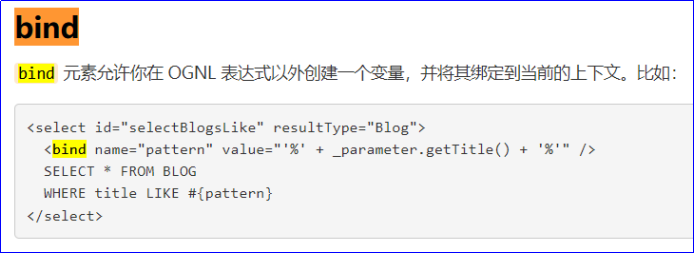两表关联查询:sql、mybatis
MySQL 8.0.33
mybatis 3.5.15
mybatis-plus 3.5.5
---
序章
功能:给文本内容打标签。
文本表:text,主键 uuid,还有 content 字段。
文本标签表:text_tag,主键uuid,字段text_uuid 为 text表的主键,还有 tag_name 字段——标签名。
ben发布于博客园
需求:
查找包含所有 标签名 的文本。
数据表准备
text
CREATE TABLE `text` (
`uuid` varchar(100) NOT NULL COMMENT '主键',
`user_uuid` varchar(100) NOT NULL COMMENT '用户主键',
`content` varchar(1024) NOT NULL COMMENT '内容。原始文本,包含 空格、换行符、链接 等。',
`deleted` bit(1) NOT NULL DEFAULT b'0' COMMENT '已删除?',
`delete_time` datetime DEFAULT NULL COMMENT '删除时间',
`create_time` datetime NOT NULL DEFAULT CURRENT_TIMESTAMP COMMENT '创建时间',
`update_time` datetime NOT NULL DEFAULT CURRENT_TIMESTAMP COMMENT '更新时间',
PRIMARY KEY (`uuid`)
) ENGINE=InnoDB DEFAULT CHARSET=utf8mb4 COLLATE=utf8mb4_0900_ai_ci COMMENT='文本';text_tag
CREATE TABLE `text_tag` (
`uuid` varchar(100) NOT NULL COMMENT '主键',
`user_uuid` varchar(100) NOT NULL COMMENT '用户主键',
`text_uuid` varchar(100) NOT NULL COMMENT '文本主键',
`tag_name` varchar(50) NOT NULL COMMENT '标签名称',
`tag_order` int DEFAULT '0',
`create_time` datetime NOT NULL DEFAULT CURRENT_TIMESTAMP COMMENT '创建时间',
`update_time` datetime NOT NULL DEFAULT CURRENT_TIMESTAMP COMMENT '更新时间',
PRIMARY KEY (`uuid`),
UNIQUE KEY `uq_idx_text_tag` (`text_uuid`,`tag_name`)
) ENGINE=InnoDB DEFAULT CHARSET=utf8mb4 COLLATE=utf8mb4_0900_ai_ci COMMENT='文本标签';
SQL 部分
1个 标签名
1个标签名:a
select * from text where uuid in(
select t1.text_uuid
from text_tag t1
where t1.tag_name = 'a'
)
order by create_time desc
;ben发布于博客园
2个 标签名
2个标签名:a, b
要点:
用到了 join;
join 表自己;
on 后面有多个条件。
select * from text where uuid in(
select t1.text_uuid
from text_tag t1
join text_tag t2 on t1.text_uuid = t2.text_uuid and t1.tag_name = 'a' and t2.tag_name = 'b'
)
order by create_time desc
;多于 2个 标签名
4个标签名:a, b, c, d
要点:
多次 join 表自己。
select * from text where uuid in(
select t1.text_uuid
from text_tag t1
join text_tag t2 on t1.text_uuid = t2.text_uuid and t1.tag_name = 'a' and t2.tag_name = 'b'
join text_tag t3 on t1.text_uuid = t3.text_uuid and t3.tag_name = 'c'
join text_tag t4 on t1.text_uuid = t4.text_uuid and t4.tag_name = 'd'
)
order by create_time desc
;
通义千问 的建议
最初,通义千问 建议使用 INTERSECT(求交集) 的:
select uuid from text where uuid in (
select text_uuid from text_tag where tag_name = '1'
INTERSECT
select text_uuid from text_tag where tag_name = 'a'
)可是,自己的MySQL不支持:可 千问 说 mysql 8.0.31 就支持了。
| SELECT VERSION(); -- 8.0.33 SHOW VARIABLES LIKE 'sql_mode'; -- ONLY_FULL_GROUP_BY,STRICT_TRANS_TABLES,NO_ZERO_IN_DATE,NO_ZERO_DATE,ERROR_FOR_DIVISION_BY_ZERO,NO_ENGINE_SUBSTITUTION |
参考资料:
1. SQL INTERSECT操作符简介
https://www.yiibai.com/mysql/sql-union-mysql.html
未读 TODO。
还需调查。
ben发布于博客园
mybatis 部分
java
定义了分页查询接口:
public interface AppTextMapper extends BaseMapper<AppText> {
/**
* 分页查找:返回总数
* @param dto 入参
* @param tag1 可以为null,来自 dto tagNameList#1
* @param tag2 可以为null,来自 dto tagNameList#2
* @param tag3 可以为null,来自 dto tagNameList#3
* @param tag4 可以为null,来自 dto tagNameList#4
* @param tag5 可以为null,来自 dto tagNameList#5
* @return
*/
long pageFindCount(PageFindDTO dto,
String tag1,
String tag2,
String tag3,
String tag4,
String tag5);
/**
* 分页查找:返回 记录列表
* @param dto 入参
* @param tag1 可以为null,来自 dto tagNameList#1
* @param tag2 可以为null,来自 dto tagNameList#2
* @param tag3 可以为null,来自 dto tagNameList#3
* @param tag4 可以为null,来自 dto tagNameList#4
* @param tag5 可以为null,来自 dto tagNameList#5
* @return
*/
List<AppText> pageFindData(PageFindDTO dto,
String tag1,
String tag2,
String tag3,
String tag4,
String tag5);
}ben发布于博客园
调用 mapper 的函数(有些搞笑):
@Override
public long pageFindCount(PageFindDTO dto) {
if (Objects.isNull(dto)) {
// 可改为 抛出异常
return 0;
}
System.out.println("dto=" + dto);
List<String> tags = dto.getTagNameList();
if (CollectionUtils.isEmpty(tags)) {
return this.baseMapper.pageFindCount(dto, null, null, null, null, null);
}
// 搞笑...TODO
int size = tags.size();
switch (size) {
case 1:
return this.baseMapper.pageFindCount(dto, tags.get(0), null, null, null, null);
case 2:
return this.baseMapper.pageFindCount(dto, tags.get(0), tags.get(1), null, null, null);
case 3:
return this.baseMapper.pageFindCount(dto, tags.get(0), tags.get(1), tags.get(2), null, null);
case 4:
return this.baseMapper.pageFindCount(dto, tags.get(0), tags.get(1), tags.get(2), tags.get(3), null);
case 5:
return this.baseMapper.pageFindCount(dto, tags.get(0), tags.get(1), tags.get(2), tags.get(3), tags.get(4));
default:
return 0;
}
}这么些的原因:
在 mybatis xml 中 使用 下面的方式 获取数据失败:
- tagNameList[0]
- tagNameList.get(0)
疑问:
难道就没有其它方式了吗?
比如,mybatis xml 的 <bind> 标签?晚点 问问 通义灵码。

mybatis xml
pageFindCount 的:
要点:
<where> 的使用;
判断 dto 中 列表大小:size() == 1,两个等号。
<select id="pageFindCount" resultType="java.lang.Long">
select count(1) from text
<where>
<if test="dto.tagNameList != null and dto.tagNameList.size() > 0">
uuid in (
select t1.text_uuid from text_tag t1
<if test="dto.tagNameList.size() == 1">
WHERE t1.tag_name = #{tag1}
</if>
<if test="dto.tagNameList.size() > 1">
JOIN text_tag t2 on t1.text_uuid = t2.text_uuid
AND t1.tag_name = #{tag1}
AND t2.tag_name = #{tag2}
</if>
<if test="dto.tagNameList.size() > 2">
join text_tag t3 on t1.text_uuid = t3.text_uuid
AND t3.tag_name = #{tag3}
</if>
<if test="dto.tagNameList.size() > 3">
join text_tag t4 on t1.text_uuid = t4.text_uuid
AND t4.tag_name = #{tag4}
</if>
<if test="dto.tagNameList.size() > 4">
join text_tag t5 on t1.text_uuid = t5.text_uuid
AND t4.tag_name =#{tag5}
</if>
)
</if>
<if test="dto.startTime != null">
and create_time >= #{dto.startTime}
</if>
<if test="dto.endTime != null">
and create_time < #{dto.endTime}
</if>
<if test="dto.keywords != null and dto.keywords.size() > 0">
<foreach collection="dto.keywords" item="kw" open="" close="" separator="">
and content like concat('%', #{kw} , '%')
</foreach>
</if>
</where>
;
</select>
自测:
|
mybatis 部分 更新
注,240418 更新。
之前写的太“搞笑”了。试着用 <bind>标签进行了改进,果然行。
mapper 就是 正常的传一个 DTO 即可。
在 mybatis 的 xml 中,可以如下面的进行改造(另一个 模块的 pageFindCount 接口):
<if test="tags != null and tags.size() > 0">
<bind name="tag1" value="tags[0]"></bind>
uuid in (
select t1.record_uuid from file_tag t1
<if test="tags.size() == 1">
WHERE t1.tag_name = #{tag1} and t1.type = 1
</if>
<if test="tags.size() > 1">
<bind name="tag2" value="tags[1]"></bind>
JOIN file_tag t2 on t1.type = 1 AND t2.type = 1 AND t1.record_uuid = t2.record_uuid
AND t1.tag_name = #{tag1}
AND t2.tag_name = #{tag2}
</if>
<if test="tags.size() > 2">
<bind name="tag3" value="tags[2]"></bind>
JOIN file_tag t3 on t3.type = 1 AND t1.record_uuid = t3.record_uuid
AND t3.tag_name = #{tag3}
</if>
<if test="tags.size() > 3">
<bind name="tag4" value="tags[3]"></bind>
JOIN file_tag t4 on t4.type = 1 AND t1.record_uuid = t4.record_uuid
AND t4.tag_name = #{tag4}
</if>
<if test="tags.size() > 4">
<bind name="tag5" value="tags[4]"></bind>
JOIN file_tag t5 on t5.type = 1 AND t1.record_uuid = t5.record_uuid
AND t5.tag_name = #{tag5}
</if>
)
</if>可行。晚点再把之前的“搞笑”代码完善下。
致谢
通义千问
通义灵码
各位博主
---END---
本文链接:
https://www.cnblogs.com/luo630/p/18130381
ben发布于博客园
参考资料
1、left join on多条件深度理解
perfect-ws
已于 2022-06-17 17:34:10 修改
原文链接:
https://blog.csdn.net/cxywangshun/article/details/124472945
2、mybatis中数组和List使用下标取值以及传入多个参数时取值
zhangbeizhen18
于 2023-04-18 22:36:45 发布
https://blog.csdn.net/zhangbeizhen18/article/details/130231821
3、
ben发布于博客园
ben发布于博客园




【推荐】编程新体验,更懂你的AI,立即体验豆包MarsCode编程助手
【推荐】凌霞软件回馈社区,博客园 & 1Panel & Halo 联合会员上线
【推荐】抖音旗下AI助手豆包,你的智能百科全书,全免费不限次数
【推荐】轻量又高性能的 SSH 工具 IShell:AI 加持,快人一步